
|
Sundials Sundials Australia From The New Zealand
Garden Journal (Journal of the Royal New Zealand Institute of Horticulture),
Vol. 2, No. 1, March 1997, pp. 21-25.
During a given day the sun appears to move across the sky from East to West, causing continual changes in both the length and position of the shadow cast by any solid object. The seasonal change in the sun's height above the horizon causes further changes in the shadow's position. From the earliest times mankind has used the movement of shadows produced by the apparent movement of the sun for the reckoning of time and for the determination of important days such as religious festivals and when to plant crops for the following season. Any device which uses either the direction of the shadow cast by the sun, or (much less commonly) the length of this shadow, to divide the period between sunrise and sunset into units of time is known as a SUNDIAL.
The word gnomon is Greek for 'pointer' or 'indicator', and also 'one who knows'. Style refers to the top surface or edge of the gnomon, the part which points directly towards the Celestial Poles. The Celestial Poles are imaginary points in the sky, directly above the North and South Poles. We see a shadow only when it falls onto a receiving surface, and clearly the slope and direction of the receiving surface will affect the direction of the shadow. The most common fixed types of sundial tell the time by measuring the direction (or azimuth) of the sun's shadow using divisions marked on a dial plate set at some known angle. As the sun moves across the sky then the shadow of the gnomon moves across the scale around the dial plate. The traditional view of the earth in space shown in Figure 1 is altered in figure 2 to show the variation in the sun's position throughout the year as we see it with the flat horizon as our reference plane. The various sundial types are usually classified according to the orientation of the dial plate upon which the hours are marked. The positions of these lines are found using formulae derived from spherical trigonometry. The dial plate can be horizontal or vertical or somewhere in between (known as reclining or polar in the special case where the angle of recline is equal to the latitude angle). The dial plate can also take the form of a circular ring (armillary sphere sundial) or part of a ring (equatorial sundial) whose plane is perpendicular to the gnomon. To help you understand how a sundial functions, Figure 3 shows the main parts of a conventional horizontal sundial.
Horizontal Sundials Horizontal sundials with a gnomon inclined at the latitude angle came into general use in the 13th century and many variations were rapidly developed. Many volumes had been written on the theory of the various devices by the time mechanical clocks made their appearance in the mid-14th century. In fact, the early clocks were so inaccurate and unreliable that they had to continually be reset using the time readings provided by sundials located nearby. Horizontal sundials are popular because they tell the time throughout the entire day whenever the sun is shining, while some other types can be used only during restricted hours of the day or limited seasons of the year.
(a) The Style or Gnomon This is the part that
casts the shadow. Its upper surface must be parallel to the earth's
axis of rotation. The western side of the upper surface forms the
style which casts the time-telling shadow during the morning hours,
while the eastern side of the upper surface forms the style which
casts the time-telling shadow during the afternoon hours. (b) The Dial Plate or Dial face This is the face onto which the shadow of the gnomon is projected by the Sun's rays. A set of lines and numbers positioned on this plate allow solar time to be determined. For a horizontal sundial, this part must be precisely horizontal. (c) The Solar Noon or Lines When the sun is directly overhead (this defines SOLAR NOON for our location), the shadow of the gnomon will fall exactly between these lines. Note that if the gnomon was very thin, the two Noon lines would coincide and become one line. However, the gnomon must have some thickness for durability and therefore the distance between the Noon Lines will be the same as the thickness of the gnomon. You may find that Solar Noon does not coincide with Clock Noon in your time zone. (d) The Hour Lines When the shadow of the gnomon edge, or style, falls on one of these lines, then that line tells the solar time. For a horizontal sundial, one side of the gnomon edge (the morning style) casts the shadow which tells the time for the morning hours, and the other edge of the gnomon (the afternoon style) casts the time-telling shadow for the afternoon hours. You may add half hour lines or quarter-hour lines or even small divisions of a few minutes, according to your requirements, and within the limitations of the Dial Plate size.
Sundial makers sometimes even claim they can tell the time to within a few seconds!! For example, in the 18th century the Indian Astronomer Maharaja Sawai Jai Singh 2 felt that European instrument makers with their small brass instruments were making inaccurate measurements. He believed that larger instruments would be more accurate, so he constructed a series of observatories containing enormous masonry instruments used for solar and stellar investigations at 5 locations in India. Some of the sundials were large enough to have time divisions corresponding to increments of just 2 seconds. However, caution should be used when trying to use such small time divisions with a sundial — the 0.5 degree divergence angle of the Sun's rays caused by the finite size of the Sun means that the boundary between lightest and darkest areas of shadow is ill defined and impossible to read to this level of precision. In addition, virtually all sundials are constructed for the average conditions over the four year, leap year cycle. The variations in the Equation of Time for a given date within this four year cycle are usually quite small, but can sometimes amount to as much as 20 seconds, so claims of sundial time telling accuracies of a few seconds are quite unrealistic.
The Solar Noon line is the base line of the gnomon, and is accurately aligned along a true North-South line. The morning and afternoon hour lines on a horizontal sundial are positioned symetrically about the Solar Noon line. This means that 11am and 1pm are the same angular distance from the gnomon toe, similarly 9am and 3pm are located equidistant from the gnomon toe. The hour lines for a
correctly designed horizontal sundial radiate from the two edges
of the gnomon toe and the angular divisions are not equally spaced
around the dial plate. The angle between 6am and 7am is larger than
the angle between 11am and 12 noon, and the relative distance depends
on your latitude. In fact, for latitudes close to the equator, the
hour lines between 6am and 7 am, and between 5pm and 6pm occupy
most of the dial plate area, while the hour lines between 8am and
4pm are crowded so close together that it is difficult to read the
sundial hour divisions accurately for a large part of the day. A
simple horizontal sundial is therefore not suitable for use within
about 15 degrees of the equator, but it can be used everywhere else
on earth right up to the poles. At the equator, the angle of the
gnomon would be 0 degrees! Alternative types of sundial must be
used near the equator. Horizontal sundials are often placed on beautiful
and ornate pedestals. One splendid example is the bronze sundial
and its fine grained carved sandstone pedestal near the football
oval at Stawell, Victoria shown in Figure 6.
Web-notes: For more information on sundials, John Ward and Margaret Folkard have published the book, Sundials Australia.
This book has briefly been reviewed on the RNZIH Horticulture Pages. It is available from Touchwood Books and listed by Sundials on the Internet (sponsored by the British Sundial Society) and the USA-based company SunPath Designs. |
Home | Journal
| Newsletter | Conferences
Awards | Join
RNZIH | RNZIH Directory | Links
© 2000–2025 Royal New Zealand Institute of Horticulture
Last updated: May 17, 2003

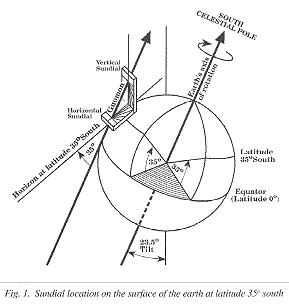 Reproduced
from an article by
Reproduced
from an article by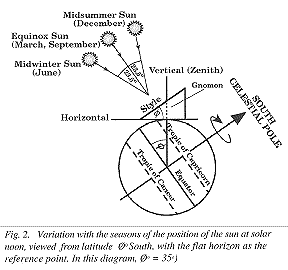 For
the majority of sundials, the gnomon (the part which casts the time-telling
shadow, pronounced NO-mon with the accent on NO) is placed so that
the upper surface is parallel to the axis of rotation of the earth.
In the Southern Hemisphere this means that the gnomon should be
aligned along a true North-South line and be inclined to the horizontal
at an angle which is equal to the latitude, with the highest point
of the gnomon nearest the South Pole. Figure 1 gives a detailed
picture for a latitude of 35 degrees South (which corresponds to
the location of Adelaide or Canberra).
For
the majority of sundials, the gnomon (the part which casts the time-telling
shadow, pronounced NO-mon with the accent on NO) is placed so that
the upper surface is parallel to the axis of rotation of the earth.
In the Southern Hemisphere this means that the gnomon should be
aligned along a true North-South line and be inclined to the horizontal
at an angle which is equal to the latitude, with the highest point
of the gnomon nearest the South Pole. Figure 1 gives a detailed
picture for a latitude of 35 degrees South (which corresponds to
the location of Adelaide or Canberra).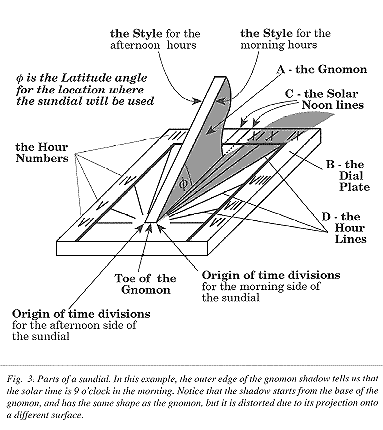
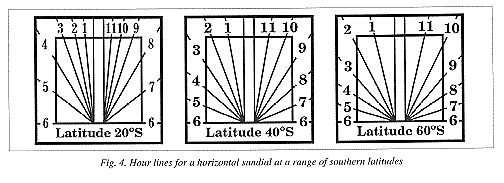
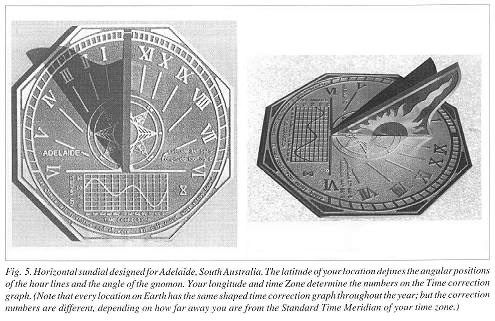
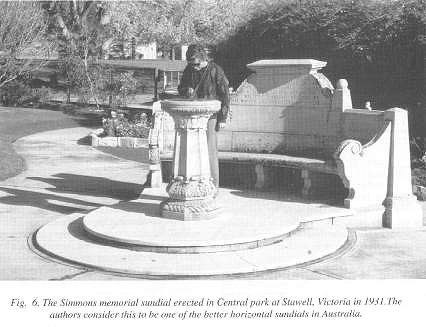
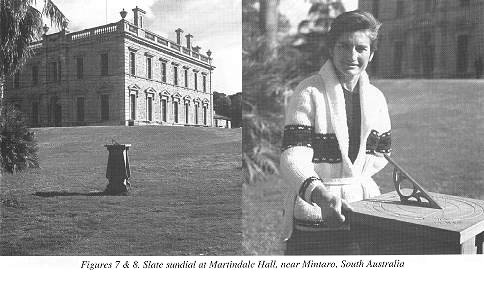
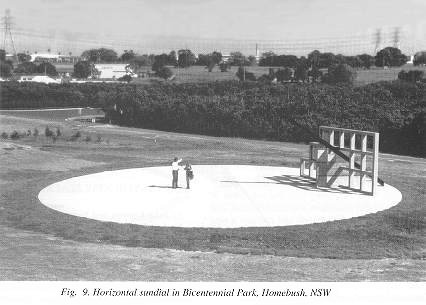
 Published
1996, 113 pages, A4 size, 90 black and white photographs and 100
line drawings. This authoritative book includes relevant facts about
the Earth, Sun and stars, and the various types of sundial, and
the relationship between sun and clock time. Formulae for calculating
hour lines are clearly listed. The blackness and sharpness of shadows
is discussed. There is also a collection of mottoes, a dictionary
of sundial terms, and a list of references. Price $A20 plus $A9
overseas postage.
Published
1996, 113 pages, A4 size, 90 black and white photographs and 100
line drawings. This authoritative book includes relevant facts about
the Earth, Sun and stars, and the various types of sundial, and
the relationship between sun and clock time. Formulae for calculating
hour lines are clearly listed. The blackness and sharpness of shadows
is discussed. There is also a collection of mottoes, a dictionary
of sundial terms, and a list of references. Price $A20 plus $A9
overseas postage.